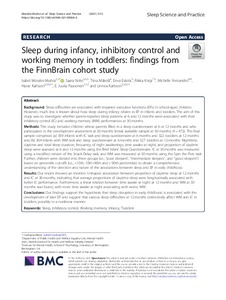Sleep during infancy, inhibitory control and working memory in toddlers: findings from the FinnBrain cohort study
Karlsson Hasse E.; Eskola Eeva; Morales-Muñoz Isabel; Nolvi Saara; Mäkelä Tiina; Fernandes Michelle; Karlsson Linnea; Paavonen Juulia; Korja Riikka
https://urn.fi/URN:NBN:fi-fe2022022320649
Tiivistelmä
Background
Sleep difficulties are associated with impaired executive functions (EFs) in school-aged children. However, much less is known about how sleep during infancy relates to EF in infants and toddlers. The aim of this study was to investigate whether parent-reported sleep patterns at 6 and 12 months were associated with their inhibitory control (IC) and working memory (WM) performances at 30 months.
Methods
This study included children whose parents filled in a sleep questionnaire at 6 or 12 months and who participated in the development assessment at 30 months (initial available sample at 30 months; N = 472). The final sample comprised (a) 359 infants with IC task and sleep questionnaire at 6 months and 322 toddlers at 12 months and (b) 364 infants with WM task and sleep questionnaire at 6 months and 327 toddlers at 12 months. Nighttime, daytime and total sleep duration, frequency of night awakenings, time awake at night, and proportion of daytime sleep were assessed at 6 and 12 months using the Brief Infant Sleep Questionnaire. IC at 30 months was measured using a modified version of the Snack Delay task, and WM was measured at 30 months using the Spin the Pots task. Further, children were divided into three groups (i.e., “poor sleepers”, “intermediate sleepers”, and “good sleepers”) based on percentile cut-offs (i.e., <10th, 10th–90th and > 90th percentiles) to obtain a comprehensive understanding of the direction and nature of the associations between sleep and EF in early childhood.
Results
Our results showed an inverted U-shaped association between proportion of daytime sleep at 12 months and IC at 30 months, indicating that average proportions of daytime sleep were longitudinally associated with better IC performance. Furthermore, a linear relation between time awake at night at 12 months and WM at 30 months was found, with more time awake at night associating with worse WM.
Conclusions
Our findings support the hypothesis that sleep disruption in early childhood is associated with the development of later EF and suggest that various sleep difficulties at 12 months distinctively affect WM and IC in toddlers, possibly in a nonlinear manner.
Kokoelmat
- Rinnakkaistallenteet [19204]
